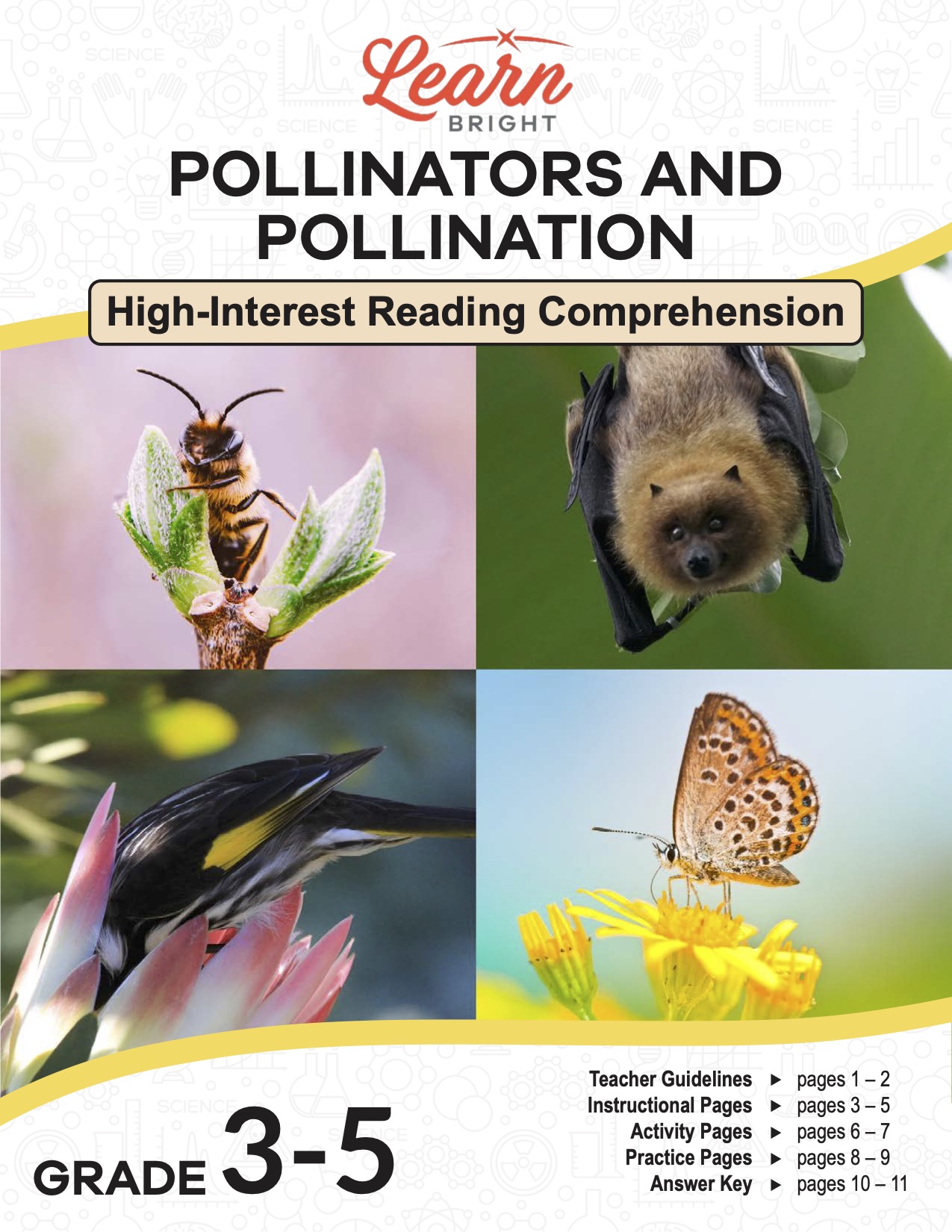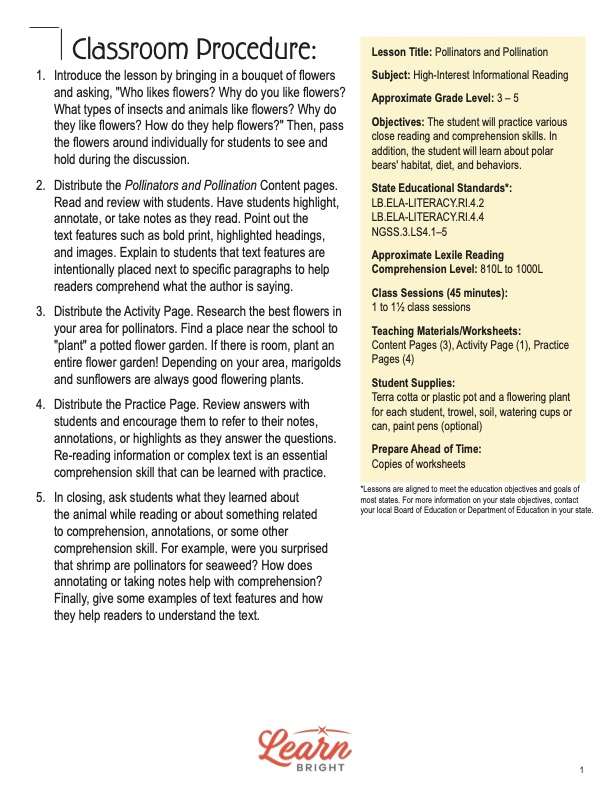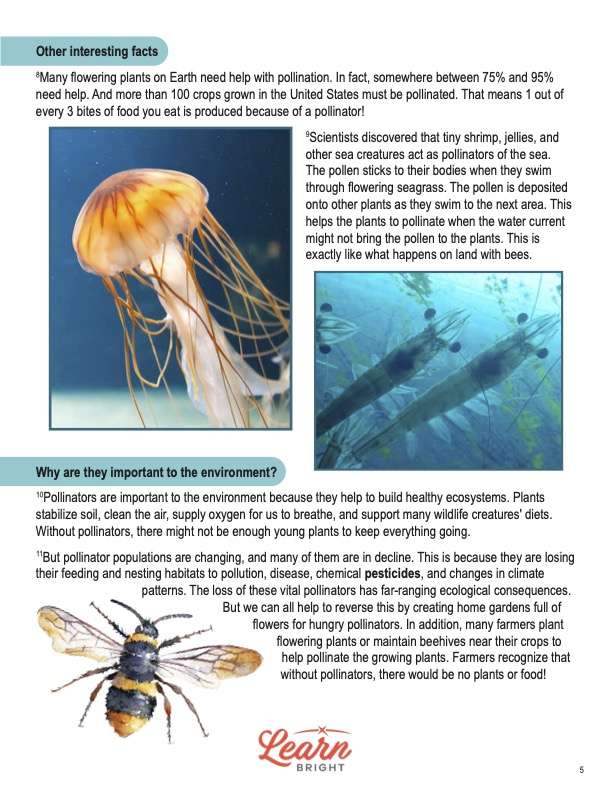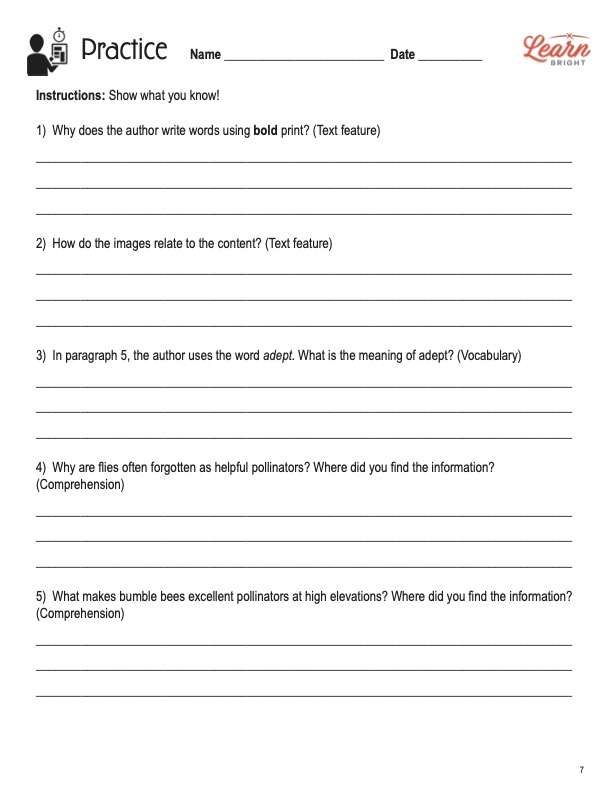Description
What our Pollinators and Pollination lesson plan includes
Lesson Objectives and Overview: Pollinators and Pollination is a high-interest reading comprehension lesson plan. As such, students will practice various close reading and comprehension skills. In addition, they will learn about the habitat, diet, and behaviors of different pollinators. This lesson is for students in 3rd grade, 4th grade, and 5th grade.
Classroom Procedure
Every lesson plan provides you with a classroom procedure page that outlines a step-by-step guide to follow. You do not have to follow the guide exactly. The guide helps you organize the lesson and details when to hand out worksheets. It also lists information in the yellow box that you might find useful. You will find the lesson objectives, state standards, and number of class sessions the lesson should take to complete in this area. In addition, it describes the supplies you will need as well as what and how you need to prepare beforehand.
Teacher Notes
The teacher notes page provides an extra paragraph of information to help guide the lesson. It explains that you can teach this lesson in a whole-class setting or as an independent, small-group activity. You can use the blank lines to write down any other ideas or thoughts you have about the topic as you prepare.
POLLINATORS AND POLLINATION LESSON PLAN CONTENT PAGES
What Is Pollination?
The Pollinators and Pollination lesson plan contains three content pages. To start off, it provides a small box with basic background information about the world’s pollinators. Birds, bees, butterflies, bats, and several others are all pollinators. We can find these helpful creatures in nearly every habitat on Earth. Their diets and life spans vary by species.
Pollination is a process that produces seeds, fruits, and young plants. It happens when a pollen grain moves from the flower’s anther (male part) to the stigma (female part). Wind and water help to transfer pollen and some plants self-pollinate. But most plants are pollinated through the hard work of insects and animals. These insects and animals move pollen from one blooming flower to another to fertilize the plant.
Bees, wasps, moths, butterflies, birds, flies, and small mammals like bats use flowers for different reasons. Some search for food and shelter, while others search for nesting materials or mates. Pollinators may move pollen on purpose, while others do it by accident. Pollen often sticks to their bodies while inside a flower bloom drinking or feeding on nectar. Then as they move from flower to flower, it is transported, resulting in pollination.
Who Are the Pollinators?
Students will learn that there are many different pollinators because there are many kinds of plants. Solitary bees, like honeybees, are the most well known pollinator. However, those make up only a tiny portion of all bee species. In fact, there are over 20,000 different bee species. Solitary bees are not aggressive; many can’t even sting. These bees are excellent pollinators because they have hairs and other specialized body parts that collect and transfer pollen. As a result, they are very effective at pollinating plants.
Bumble bees are also important pollinators. They pollinate wild flowering plants and agricultural crops like tomatoes, peppers, and cranberries. Unlike many other bees, bumble bees can fly in cool temperatures and see well in low light. This makes them excellent pollinators at high elevations. Bumble bees buzz and pollinate. This involves grasping a flower in their mouth and then vibrating (continuously moving back and forth) their wing muscles to dislodge the pollen.
While most people don’t like wasps for their aggressiveness and painful sting, wasps are very important for pollination. They are adept at hunting, which means they are skilled or proficient at keeping the insect population balanced. While they don’t have fuzzy bodies like a bee to collect pollen, they accidentally pollinate flowers by carrying and dropping pollen grains as they move among flowers.
Other Interesting Facts
Flies can be terrible pests and carry diseases, but some flies are beneficial. For example, flies help to pollinate apples, peppers, mangoes, and even cashews. But because they don’t have nests and their bodies are not hairy, we forget that they are helpful pollinators too.
7Beetles are the most diverse group of organisms in the world! Like a rainbow, they also come in lots of different colors. Scientists believe that 150 million years ago, beetles were probably the first pollinators. They would have crawled in and out of prehistoric flowering plants.
Many flowering plants on Earth need help with pollination. In fact, somewhere between 75% and 95% need help. And more than 100 crops grown in the United States must be pollinated. That means 1 out of every 3 bites of food you eat is produced because of a pollinator!
Scientists discovered that tiny shrimp, jellies, and other sea creatures act as pollinators of the sea. The pollen sticks to their bodies when they swim through flowering seagrass. The pollen is deposited onto other plants as they swim to the next area. This helps the plants to pollinate when the water current might not bring the pollen to the plants. This is exactly like what happens on land with bees.
Why They Are Important
Pollinators are important to the environment because they help to build healthy ecosystems. Plants stabilize soil, clean the air, supply oxygen for us to breathe, and support many wildlife creatures’ diets. Without pollinators, there might not be enough young plants to keep everything going.
But pollinator populations are changing, and many of them are in decline. This is because they are losing their feeding and nesting habitats to pollution, disease, chemical pesticides, and changes in climate patterns. The loss of these vital pollinators has far-ranging ecological consequences. But we can all help to reverse this by creating home gardens full of flowers for hungry pollinators. In addition, many farmers plant flowering plants or maintain beehives near their crops to help pollinate the growing plants. Farmers recognize that without pollinators, there would be no plants or food!
POLLINATORS AND POLLINATION LESSON PLAN WORKSHEETS
The Pollinators and Pollination lesson plan includes two worksheets: an activity worksheet and a practice worksheet. Each one will help students solidify their grasp of the material they learned throughout the lesson. You can refer to the classroom procedure guidelines to know when to hand out each worksheet.
GARDEN AND APIARY ACTIVITY WORKSHEET
There are two activities for this lesson plan. For the first, students will create a garden that will attract pollinators. They will first talk with a horticulturist or expert in the agricultural community to learn which plants attract pollinators. Then they will choose a pot and decorate it with the paint pens you provide. Finally, they will add an plant and secure it in the pot with soil. Once all the students have put their pots together, they can put them in a designated garden area. Eventually, the garden will bloom, and students can then observe which types of pollinators their plants attract.
If possible, visit an apiary for the second activity. Have the apiarist explain how bees pollinate plants and which plants bees tend to favor. While there, enjoy some fresh honey!
POLLINATORS AND POLLINATION PRACTICE WORKSHEET
The practice worksheet requires students to answer a series of 11 questions. These questions all relate to the content pages, so students will need to refer to them often for the answers. In addition, each question provides which reading tool the question corresponds to, such as text feature, vocabulary, or comprehension.
Worksheet Answer Keys
At the end of the lesson plan document is an answer key for the practice worksheet. The correct answers are all in red to make it easier for you to compare them with students’ responses. If you choose to administer the lesson pages to your students via PDF, you will need to save a new file that omits these pages. Otherwise, you can simply print out the applicable pages and keep these as reference for yourself when grading assignments.










